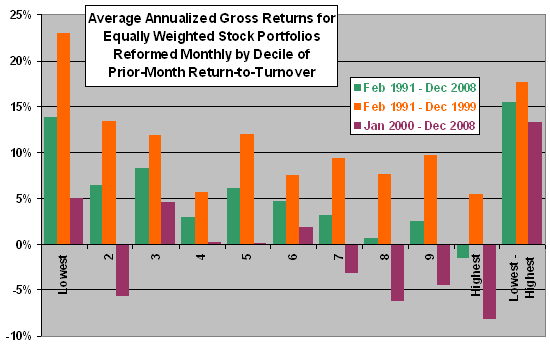Over the past two decades, stock trading frictions (transaction fees and bid-ask spreads) have dramatically decreased on a per-trade basis, but trading frequency (share turnover) has dramatically increased. Does turnover now dominate per-trade friction in impacting asset prices? In the June 2010 draft of their paper entitled “Trading Frequency and Asset Pricing: Evidence from a New Price Impact Ratio”, Chrisostomos Florackis, Andros Gregoriou and Alexandros Kostakis investigate the return-to-turnover ratio (monthly average of daily ratios of absolute stock return to volume as a percentage of shares outstanding) as a new measure of the price impact of trading. Using daily data for a broad sample of stocks listed on the London Stock Exchange over the period 1991-2008, they find that:
- Stocks with the lowest return-to-turnover ratios generate much higher risk-adjusted returns than those with the highest ratios, supporting a view that trading frequency dominates per-trade friction in determining the liquidity premium.
- The tenth of stocks with the lowest return-to-turnover ratio outperform the tenth with the highest ratio by an average 15.4% (12.5%) per year over the entire sample period on an equal-weighted (value-weighted) basis. Results are similar for two approximately equal sub-periods (see the chart below).
- Unlike the widely used return-to-volume measure (with volume in monetary units), return to turnover is free of market capitalization bias. The premium associated with return-to-volume disappears after accounting for the size factor.
- A price impact factor, defined as the difference in average returns of the tenths of stocks with the lowest and highest return-to-turnover ratios, enhances the explanatory power of the four-factor (market, size, book-to-market and momentum) model of asset returns and partly explains momentum.
The following chart, constructed from data in the paper, shows the average annualized gross returns for equally weighted portfolios reformed monthly by decile of prior-month return-to-turnover ratio over the entire sample period and two subperiods. Although progressions across deciles are not completely systematic, results generally show that stocks with low past return-to-turnover ratios outperform those with high ratios, regardless of general market conditions.

In summary, evidence indicates that investors may be able to exploit a systematic relationship between the price impact of trading as measured by the return-to-turnover ratio and future stock returns.
A possible interpretation is that temporarily high (low) turnover suppresses (elevates) the liquidity premium, which subsequently reverts as turnover returns to normal.